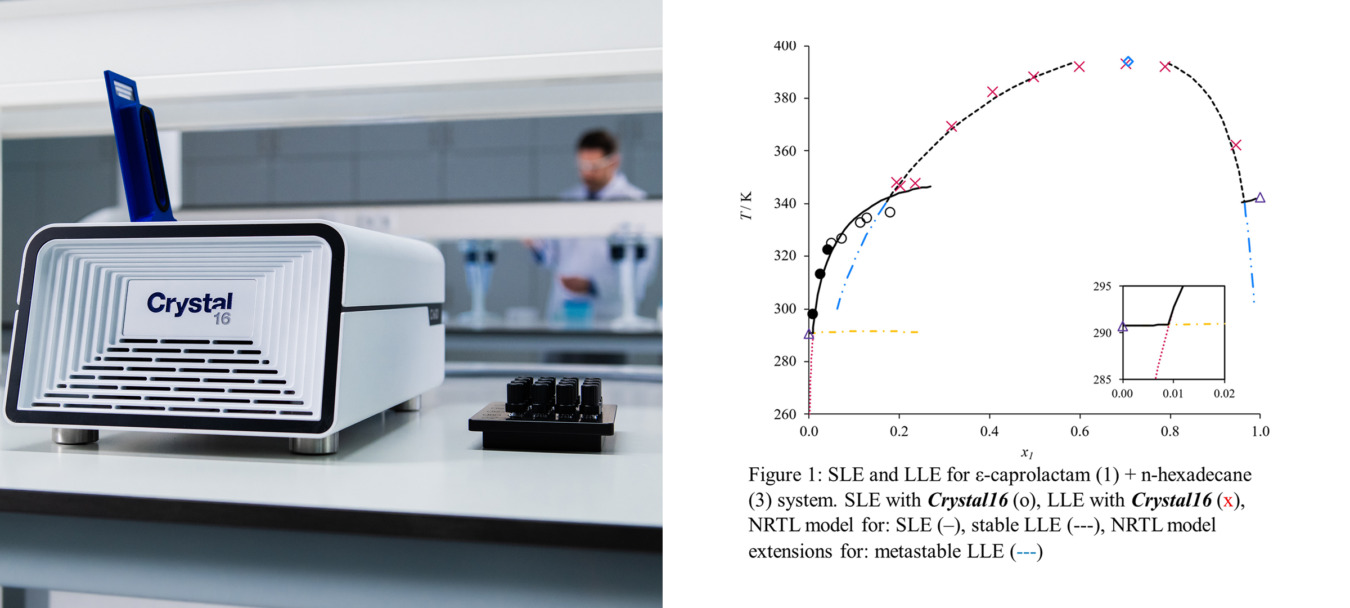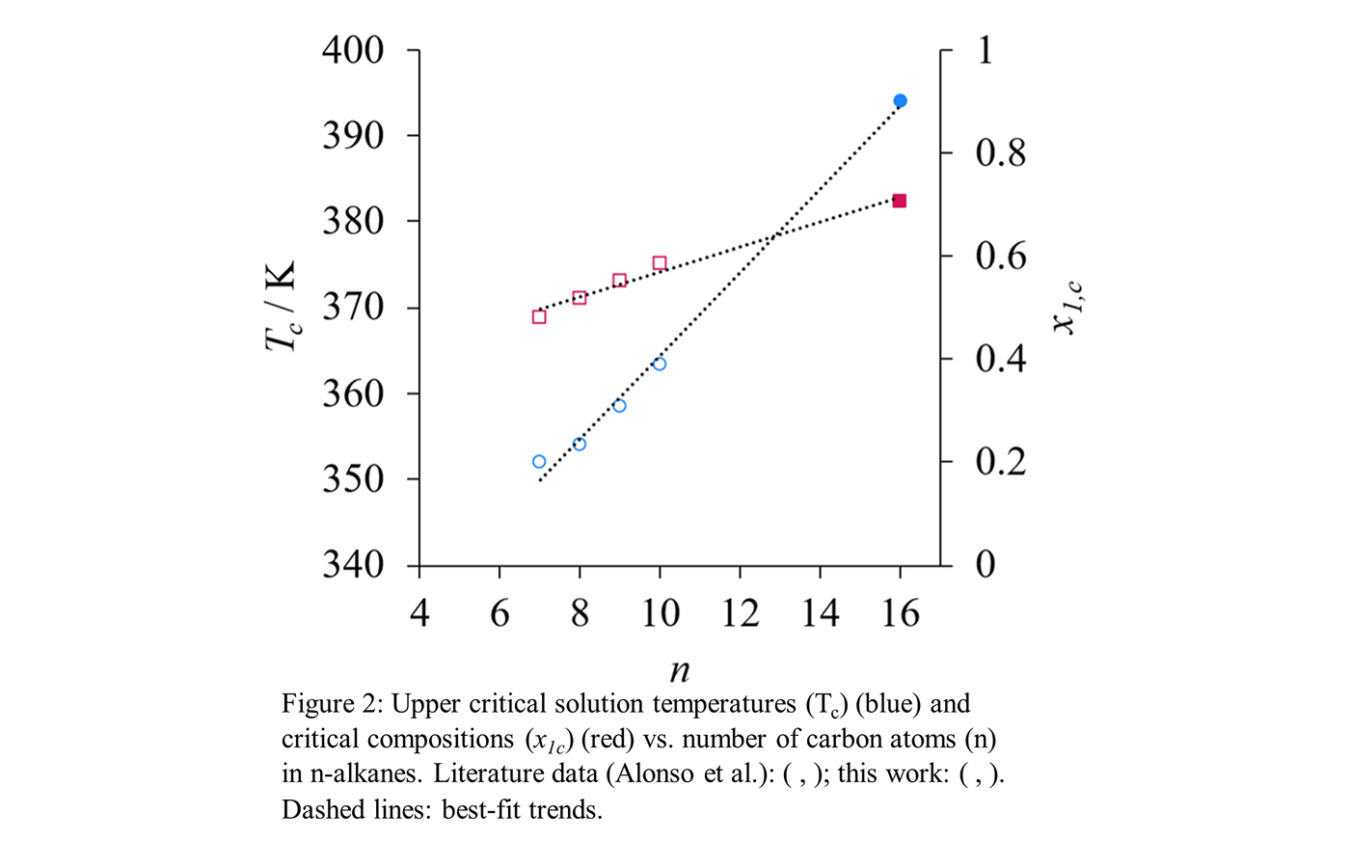Introduction
Efficient recovery of ε-caprolactam, the monomer of Nylon-6, from waste streams requires accurate phase equilibrium data to optimize separation processes.
A team of researchers from Aalto University in Finland recently published a study that investigates the phase equilibria of systems containing ε-caprolactam, water, n-hexadecane, and o-xylene to support the development of separation strategies in plastic recycling. Solid–liquid (SLE) and liquid–liquid equilibria (LLE) were determined for binary and ternary mixtures using analytical methods and the Crystal16 crystallization system. Results showed distinct phase behaviors, such as eutectic points and immiscibility regions, and were effectively correlated with the NRTL thermodynamic model.
Experimental procedure
Binary solid–liquid and liquid–liquid equilibria (SLE and LLE) for the ε-caprolactam + n-hexadecane system were measured using the Crystal16 instrument.
Samples were gravimetrically prepared directly in 1.5 mL HPLC vials and loaded into the instrument’s four independently temperature-controlled blocks. Experiments were conducted over a temperature range of 293–393 K, with a ramp rate of 0.5 K/min, three heating–cooling cycles, a 10-minute hold at the maximum temperature, and stirring at 700 RPM. Prior to measurements, the system was tuned using solvent-only vials to establish the maximum transmittance baseline. Phase changes were identified using in-line transmittance monitoring integrated into each reactor. During the thermal cycles, the Crystal16 software automatically detected clear and cloud points, with clear points (100% transmittance) used to define the equilibrium conditions for SLE and LLE.
Results and discussion
The transmittance-based method allowed the detection of sharp transitions between single-phase and two-phase regions. At lower concentrations of ε-caprolactam, clear points were recorded in the range of 298–333 K, which corresponded to SLE transitions, where ε-caprolactam solubility increased with temperature, as shown in figure 1.
The SLE measured analytically and with Crystal16 showed good agreement; for instance, at 322 K, the mole fraction difference was only 0.0089. However, turbidity-based methods cannot reliably distinguish between stable SLE, metastable LLE, and the transition to stable LLE. To account for this ambiguity, the NRTL model was extended to include the metastable LLE region (Figure 1).

At higher ε-caprolactam concentrations (x₁ > ~0.2), the system exhibited liquid–liquid phase separation, observed as a drop in transmittance followed by recovery upon further heating, indicating the presence of upper critical solution temperature (UCST) behavior. The LLE region spanned a broad temperature and composition range, and the UCST was estimated at ~394 K with a corresponding critical composition near x₁ = 0.707 (Figure 2). These clear points closely matched analytical data, supporting the robustness of Crystal16 for mapping two-phase regions.

Conclusion
This study provides valuable insights into phase equilibrium behavior in low-solubility binary systems, supporting the design of efficient separation processes for ε-caprolactam recovery in recycling streams.
Crystal16 played a key role in generating high-resolution SLE and LLE data rapidly and efficiently, enabling robust thermodynamic modeling. The results highlight water’s strong solvating capability and the limited compatibility of n-hexadecane, emphasizing the critical role of solvent selection in waste plastic valorization.
These findings are particularly relevant for the recovery of ε-caprolactam and the development of chemical recycling processes for Nylon-6 waste.
References
We thank the authors for their valuable contributions and insights! Read the full article:
Zubair Riaz, Petri Uusi-Kyyny, Roshi Dahal, Juha-Pekka Pokki, Ville Alopaeus. Ternary Liquid – Liquid and Binary Liquid – Liquid, Solid – Liquid, and Vapour – Liquid equilibria of systems containing ε Caprolactam, Water, n-Hexadecane, and o-Xylene. Fluid Phase Equilibria, Volume 598, 2025, 114503, ISSN 0378-3812, https://www.sciencedirect.com/science/article/pii/S0378381225001736
See the Crystal16 in action
Can Crystal16 accelerate your pharmaceutical research? Let's run a demo – online or in your lab – to find out.